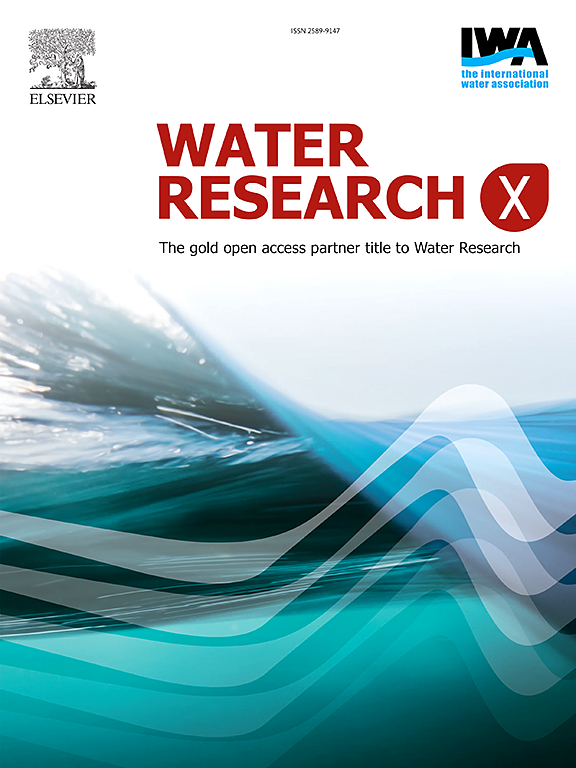木屑-黄铁矿生物截留系统脱氮和控制N₂O排放的机理
IF 8.2
2区 环境科学与生态学
Q1 ENGINEERING, ENVIRONMENTAL
引用次数: 0
摘要
生物截留作为一种灵活、经济的绿色基础设施,在城市雨水管理中得到了广泛的应用。目前改良的生物保留策略主要集中在提高氮去除效率上,而针对其减缓N2O潜力的研究仍然有限。本研究比较了木屑-黄铁矿生物保留率(W-PB)与砂生物保留率(SB)和黄铁矿生物保留率(PB)的性能。量化了3种系统的反硝化性能和N2O排放,并从微生物代谢功能的角度阐明了N2O减缓机制。在120天的监测期内,W-PB中硝酸盐的平均去除率为81.4%±11.2%。W-PB中N2O的平均排放通量为13.21±3.06 μgN2ON/(m2·h),比SB和PB分别减少了41.4%和28.5%。扫描电镜结果表明,木屑的加入促进了黄铁矿的分解,从而增加了反硝化的给电子体。这种增强进一步体现在W-PB中电子传递系统活性的增强以及NIR和NOS酶活性的升高,表明反硝化过程更加完整。结果表明,潜水区反硝化电位达到0.3735±0.0022 ng N/(g·h),分别是SB和PB的3.35和2.06倍。此外,高通量测序结果显示,W-PB中微生物的丰度和多样性有所增加。研究结果为生物滞留系统在城市雨水脱氮中的低碳优化和工程应用提供了理论和技术支持。本文章由计算机程序翻译,如有差异,请以英文原文为准。

Mechanisms of woodchip-pyrite bioretention systems for nitrogen removal and N₂O emission control
Bioretention, as one of the flexible and economical green infrastructures, is widely used for urban stormwater management. Current modified strategies for bioretention have largely focused on improving nitrogen removal efficiency, while studies addressing their potential for N2O mitigation remain limited. In this study, the performance of woodchip-pyrite bioretention (W-PB) was compared with that of sand bioretention (SB) and pyrite bioretention (PB). The denitrification performance and N2O emissions of the three systems were quantified, and the underlying N2O mitigation mechanism was elucidated from the perspective of microbial metabolic functions. During a 120-day monitoring period, the average removal efficiency of nitrate in W-PB was 81.4 % ± 11.2 %. The average N2O emission flux in W-PB was 13.21 ± 3.06 μgN2O![]() N/(m2·h), which represents reductions of 41.4 % and 28.5 % compared to the SB and PB, respectively. Scanning electron microscope results indicated that the addition of woodchips enhanced the decomposition of pyrite, thereby increasing the electron donors for denitrification. This enhancement was further reflected by the increased activity of the electron transfer system and the elevated activities of NIR and NOS enzymes in the W-PB, suggesting a more complete denitrification process. As a result, the denitrification potential in the submerged zone reached 0.3735 ± 0.0022 ng N/(g·h), which was 3.35 and 2.06 times higher than that in SB and PB, respectively. Additionally, high-throughput sequencing results show an increased microbial abundance and diversity in W-PB. The results provide theoretical and technical support for the low-carbon-oriented optimization and engineering application of bioretention systems in urban stormwater nitrogen removal.
N/(m2·h), which represents reductions of 41.4 % and 28.5 % compared to the SB and PB, respectively. Scanning electron microscope results indicated that the addition of woodchips enhanced the decomposition of pyrite, thereby increasing the electron donors for denitrification. This enhancement was further reflected by the increased activity of the electron transfer system and the elevated activities of NIR and NOS enzymes in the W-PB, suggesting a more complete denitrification process. As a result, the denitrification potential in the submerged zone reached 0.3735 ± 0.0022 ng N/(g·h), which was 3.35 and 2.06 times higher than that in SB and PB, respectively. Additionally, high-throughput sequencing results show an increased microbial abundance and diversity in W-PB. The results provide theoretical and technical support for the low-carbon-oriented optimization and engineering application of bioretention systems in urban stormwater nitrogen removal.
求助全文
通过发布文献求助,成功后即可免费获取论文全文。
去求助
来源期刊

Water Research X
Environmental Science-Water Science and Technology
CiteScore
12.30
自引率
1.30%
发文量
19
期刊介绍:
Water Research X is a sister journal of Water Research, which follows a Gold Open Access model. It focuses on publishing concise, letter-style research papers, visionary perspectives and editorials, as well as mini-reviews on emerging topics. The Journal invites contributions from researchers worldwide on various aspects of the science and technology related to the human impact on the water cycle, water quality, and its global management.
 求助内容:
求助内容: 应助结果提醒方式:
应助结果提醒方式:


